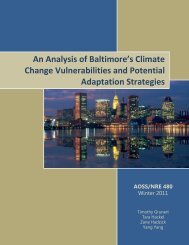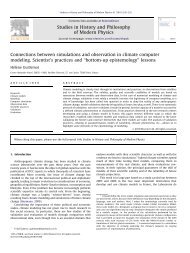Lal, Carbon Sequestration, PhilTransRoySoc 2008
Lal, Carbon Sequestration, PhilTransRoySoc 2008
Lal, Carbon Sequestration, PhilTransRoySoc 2008
Create successful ePaper yourself
Turn your PDF publications into a flip-book with our unique Google optimized e-Paper software.
Downloaded from rstb.royalsocietypublishing.org on April 14, 2010<strong>Carbon</strong> sequestration R. <strong>Lal</strong> 821uptake in C-3 dominated tropical regions in eight of the10-year study period. Their data showed a possibleexistence of a large equatorial terrestrial CO 2 sink.Pacala & Socolow’s (2004) estimated managementof temperate and tropical forest is one of the 15 optionsto stabilize atmospheric CO 2 concentration at 550 ppmby 2050. They estimated that 0.5 Pg C emission wouldbe avoided if the current rate of clear cutting of primarytropical forest were reduced to zero over 50 years by2050. Another 0.5 Pg C yr K1 would be sequestered byreforesting or afforesting approximately 250 Mha in thetropics or 400 Mha in the temperate zone. Anadditional 0.3 Pg C yr K1 can be sequestered by establishingapproximately 300 Mha of plantations ofnon-forested lands (Pacala & Socolow 2004). Theafforestation may account for a total of 25 Pg Csequestration between 2000 and 2050.However, afforestation on a large scale can impactwater resources. Jackson et al. (2005) documentedsubstantial losses in stream flow, and increased soilsalinization and acidification, with afforestation. Theyobserved that establishment of tree plantationsdecreased stream flow by 227 mm yr K1 globally(52%), with 13% of streams drying completely for atleast one year. Thus, any plans of large-scale afforestationfor C sequestration must consider the possibleadverse impact on availability of water.Bunker et al. (2005) addressed the concern ofdecline in tropical forest biodiversity due to expansionof monoculture plantations. Thus, resulting effects ofmonoculture plantations on key ecosystem services(e.g. biodiversity, water resources, elemental cycling, Csequestration) must be critically assessed. There is astrong need for developing regulatory policies, includingthe transaction costs of trading C credits andobtaining the permits. The cost of C sequestration visà-visthe opportunity cost must also be considered(McCarl & Schneider 2001).Wetlands and the associated soils or histosolsconstitute a large pedologic pool estimated at approximately450 Pg (Gorham 1991; Warner et al. 1993).Wetland soils may contain as much as 200 times moreC than the associated vegetation (Milne & Brown1997; Garnett et al. 2001). Gorham (1991) and Kobaket al. (1998) estimated that C sequestration in wetlands/peatsoilssince the post-glaciation period resultedin the C accumulation at the rate of 0.1 Pg C yr K1 over10 000–18 000 years. However, drainage of peatlandsand their subsequent cultivation made these ecosystemsa net source of CO 2 . Large areas of wetlands havebeen drained worldwide for agriculture (Armentano &Menges 1986) and forestry (Paavilainen & Paivanen1995). Drained wetland soils decompose and subsideat the rate of approximately 1–2 cm yr K1 primarily dueto oxidation (Rojstaczer & Deverel 1995; Hillman1997; Wosten et al. 1997). Restoration of wetlands canlead to reversal of the process and make restoredwetlands once again a sink of atmospheric CO 2 .However, there is a long time lag after the restorationuntil processes in restored wetlands become similar tothose of natural wetlands.Soil C sequestration. Implies enhancing the concentration/poolsof SOC and SIC as secondary carbonatesthrough land-use conversion and adoption ofrecommended management practices (RMPs) inagricultural, pastoral and forestry ecosystems andrestoration of degraded and drastically disturbedsoils. Formation of charcoal and use of biochar as afertilizer is another option (Fowles 2007). In contrastto geological sequestration that implies injecting CO 2at 1–2 km depth, the SOC sequestration involvesputting C into the surface layer of 0.5–1 m depththrough the natural processes of humification. Mostsoils under the managed ecosystems contain a lowerSOC pool than their counterparts under naturalecosystems owing to the depletion of the SOC pool incultivated soils. The most rapid loss of the SOC pooloccurs in the first 20–50 years of conversion of naturalto agricultural ecosystems in temperate regions and5–10 years in the tropics (<strong>Lal</strong> 2001). In general,cultivated soils normally contain 50–75% ofthe original SOC pool. The depletion of the SOCpool is caused by oxidation/mineralization, leachingand erosion.Strategies for increasing the SOC pool are outlinedin figure 4. There is a wide range of degraded soils witha depleted SOC pool. Important among these are thosedegraded by erosion, nutrient depletion, acidificationand leaching, structural decline and pollution/contamination(figure 4). Restoring degraded soils andecosystems is a strategy with multiple benefits forwater quality, biomass productivity and for reducingnet CO 2 emission. Grainger (1995) estimated thatthere are approximately 750 Mha of degraded lands inthe tropics with potential for afforestation and soilquality enhancement. With a sequestration potential ofapproximately 0.5 Mg ha K1 yr K1 as SOC and anadditional 1.0 Mg ha K1 yr K1 as biomass, a terrestrialC sequestration potential of 750 Mha is approximately1.1 Pg C yr K1 . <strong>Lal</strong> (2001) estimated the SOC sequestrationpotential of 0.4–0.7 Pg C yr K1 through desertificationcontrol in soils of arid and semi-aridregions. Similar estimates were provided by Squireset al. (1995).West & Post (2002) assessed SOC sequestration rateupon conversion of plough tillage to no-till farmingthrough analyses of data of 67 long-term experimentsfrom around the world. They reported the mean rate ofSOC sequestration of 570G140 Kg C ha K1 yr K1 ,which may lead to the new equilibrium SOC pool in40–60 years. <strong>Lal</strong> (2004a,b) estimated the global SOCsequestration potential, 0.4–1.2 Pg C yr K1 or 5–15%,of the global fossil fuel emissions. Pacala & Socolow(2004) estimated that conversion of plough tillage tono-till farming on 1600 Mha of cropland along withadoption of conservation-effective measures could leadto sequestration of 0.5–1 Pg C yr K1 by 2050.Integrated nutrient management (INM) is alsoessential to SOC sequestration. The humificationprocess can be severely constrained by the lack of N,P, S and other building blocks of soil humus (Himes1998). The efficiency of C sequestration is reducedwhen C and N are not adequately balanced (Paustianet al. 1997). Therefore, the SOC sequestration rate isenhanced by an increase in the application of biomassC(Campbell et al. 1991; Janzen et al. 1998) andN(Halvorson et al. 1999, 2002). Liebig et al. (2002)observed that high N rate treatments increased SOCPhil. Trans. R. Soc. B (<strong>2008</strong>)




